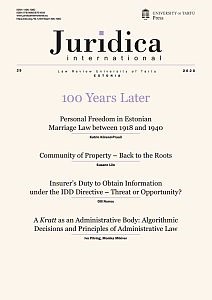A <i>Kratt</i> as an Administrative Body: Algorithmic Decisions and Principles of Administrative Law
DOI:
https://doi.org/10.12697/JI.2020.29.05Keywords:
fundamental rights, artificial intelligence, algorithmic systems, principles of administrative law, black boxAbstract
Estonia, as the number-one-ranked country in Europe for the digital public services dimension of the Digital Economy and Society Index, aims at widespread adoption of artificial-intelligence systems to assist or even replace officials in public administration. It is expected that there will be 50 artificial-intelligence applications operating in Estonian public administration by the end of 2020. The machine learning capacity that is often intrinsic in artificial intelligence systems means, in practice, that even the data analyst or programmer who wrote the respective code is later no longer able to explain the parameters behind the decisions. If the state allows a so-called black box to make administrative decisions, further constitutional issues will arise in addition to that of judicial control of such a decision. An administrative decision presumes the implementation of legislation. Owing to the vagueness of the law, a judicial appraisal does not merely involve formal-logic operations, as laws and regulations require interpretation and the consideration of the facts. This is particularly important in making discretionary decisions. Interpretation and consideration must not be limited to the predictions made on the basis of earlier, similar cases by means of statistical methods. It is not rare that a decision on applying a standard needs to be made also in a situation that the legislator has been unable to foresee and for which there is no requisite pattern emerging in the training data fed to an algorithm. The article examines the related principles arising from the Constitution, and one of the conclusions drawn from these is that for factually or legally complex decisions, the weight of the decision must be borne by humans, at least until much more powerful artificial intelligence is developed. However, with the help of learning algorithms individual components and elements of such decisions can be taken. Full automation remains an option in cases of routine administrative decisions that are advantageous for the person(s) concerned and that lack negative side effects for them, as well in cases where all relevant factual circumstances are comprehensible to an algorithm as such and transparent.


